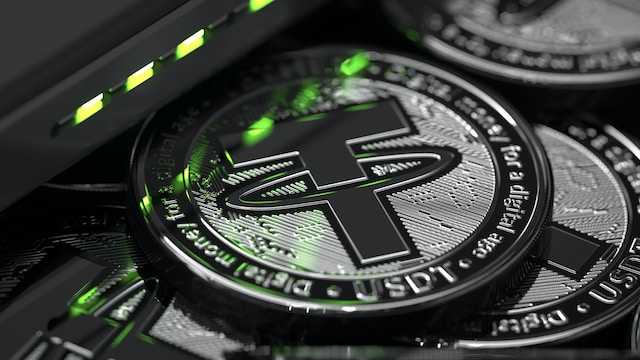Amidst the thriving landscape of cryptocurrency, digital assets have emerged as a focal point of interest. Tether (USDT) belongs to a unique category of digital assets known as stablecoins – designed to uphold a constant value – often tethered to traditional fiat currencies like the US dollar. For novice traders venturing into the realm of USDT for the first time, the significance of comprehending its bedrock principles, associated perils and optimal strategies cannot be overstated.
Understanding Tether (USDT)
Before diving into trading, it’s essential to grasp the basics of Tether:
- Stablecoin Concept: USDT is a stablecoin, which means its value is intended to remain constant. One USDT is generally equivalent to one US dollar, offering stability amidst the price volatility seen in other cryptocurrencies like Bitcoin or Ethereum.
- Centralized Issuer: Unlike decentralized cryptocurrencies, Tether is centralized. It is issued by Tether Limited, a company that claims to back each USDT with a reserve of US dollars.
- Wide Adoption: USDT is one of the most widely adopted stablecoins in the crypto market, facilitating easy trading and exchanges on numerous cryptocurrency platforms.
Selecting a Secure Exchange
The first step in trading USDT is to choose a reputable and secure cryptocurrency exchange. Consider the following factors:
- Security Features: Ensure the exchange employs robust security measures, including encryption protocols, two-factor authentication (2FA) and cold storage for user funds.
- Regulatory Compliance: The exchange should comply with regulatory standards relevant to your geographic location. Adherence to Know Your Customer (KYC) and Anti-Money Laundering (AML) procedures is essential for your security.
- Reputation: Research the exchange’s history, performance and user feedback to gauge its credibility. A trusted reputation is a vital aspect of a secure trading experience.
- Liquidity: Adequate trading volume is crucial for executing trades efficiently. Choose an exchange with sufficient liquidity to avoid potential issues like slippage or market manipulation.
Creating a Secure Wallet
To engage in USDT trading, you need a secure wallet. There are several wallet options:
- Hardware Wallets: Hardware wallets, such as Ledger Nano S or Trezor, provide the highest level of security by storing your USDT offline. These wallets are ideal for long-term storage of USDT.
- Software Wallets: Software wallets offer convenience but should primarily be used for smaller, everyday transactions. Opt for well-established software wallets from trusted sources and ensure they are regularly updated.
- Exchange Wallets: Many cryptocurrency exchanges provide wallets for their users. While convenient, this option means you are trusting the exchange with the security of your funds, which carries inherent risks.
Vigilance Against Phishing Scams
Phishing scams are a prevalent threat in the crypto world. These scams involve fraudulent websites and emails designed to trick users into revealing their private keys or login information. To protect against phishing attempts:
- URL Verification: Scrutinize website URLs, ensuring they match the official exchange or wallet site. Be cautious of domains with spelling errors or unusual characters.
- Email Caution: Refrain from clicking on links or downloading attachments from unsolicited or suspicious emails. Legitimate entities rarely request personal information via email.
- Browser Extensions: Consider using browser extensions such as MetaMask or TronLink, which can help detect phishing sites and bolster overall browsing security.
Creating a Trading Plan
Effective trading requires a well-defined plan:
- Risk Tolerance: Determine the level of risk you are willing to undertake with each trade. Never invest more than you can afford to lose.
- Entry and Exit Strategies: Clearly define your entry and exit points for each trade. Abiding by your plan minimizes emotional decision-making.
- Stop-Loss Orders: Implement stop-loss orders to limit potential losses. This ensures that if a trade goes against you, you exit with a predetermined loss.
Two-Factor Authentication (2FA)
Enable two-factor authentication (2FA) on your exchange and wallet accounts to add an extra layer of security. Even if someone gains access to your login credentials, they will be unable to access your accounts without completing the second authentication step.
Start With a Small Investment and Stay Informed With Market News
For first-time USDT traders, it’s advisable to begin with a small investment. This allows you to become familiar with the trading process and mitigate potential losses while you gain experience.
Cryptocurrency markets are highly sensitive to news and events. Staying informed about market trends, regulatory changes and global developments that can impact the crypto market is essential. Trusted sources of news and analysis are invaluable for making well-informed trading decisions.
Keep Emotions in Check and Practice Continuous Learning
Emotional trading decisions can lead to significant losses. Stick to your trading plan and avoid impulsive actions driven by fear or greed. Discipline is a key element of successful trading.
The world of crypto trading is complex and ever-evolving. Engage in continuous learning by reading books, attending webinars and staying updated on the latest trends and strategies in the crypto market.
Conclusion
Trading Tether (USDT) for the first time can be a rewarding endeavor when approached with knowledge and diligence. By selecting a secure exchange, creating a reliable wallet, safeguarding against phishing scams, developing a trading plan and staying informed, you can navigate the world of USDT trading safely and confidently. Remember that success in crypto trading requires practice and ongoing education, so commit to continuous learning as you embark on your crypto trading journey.

